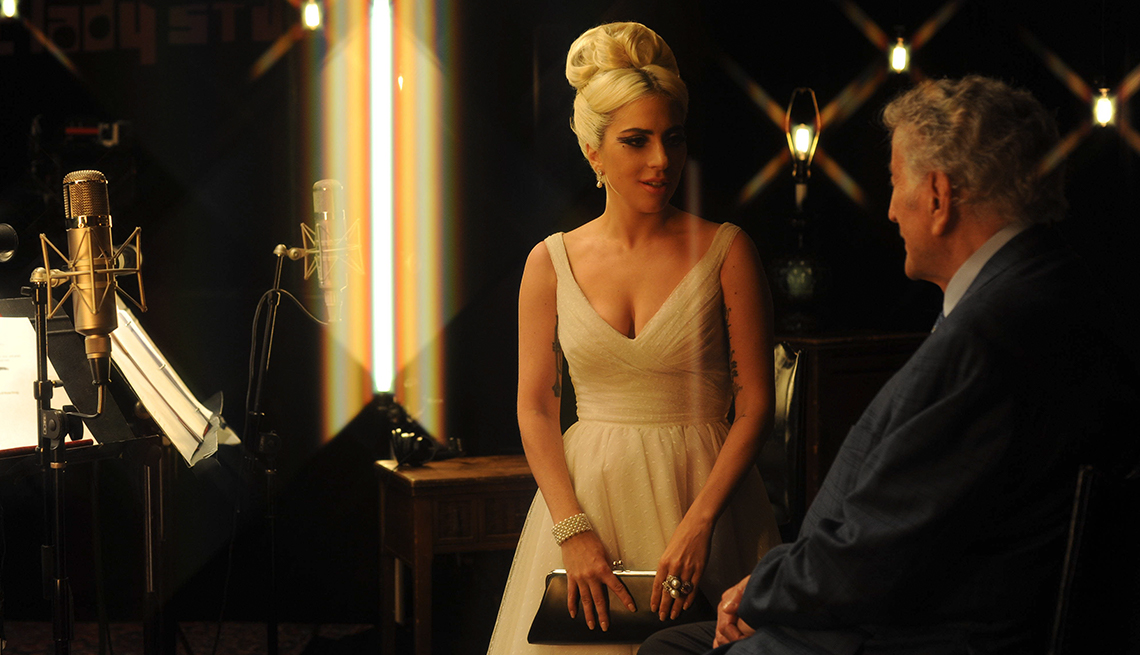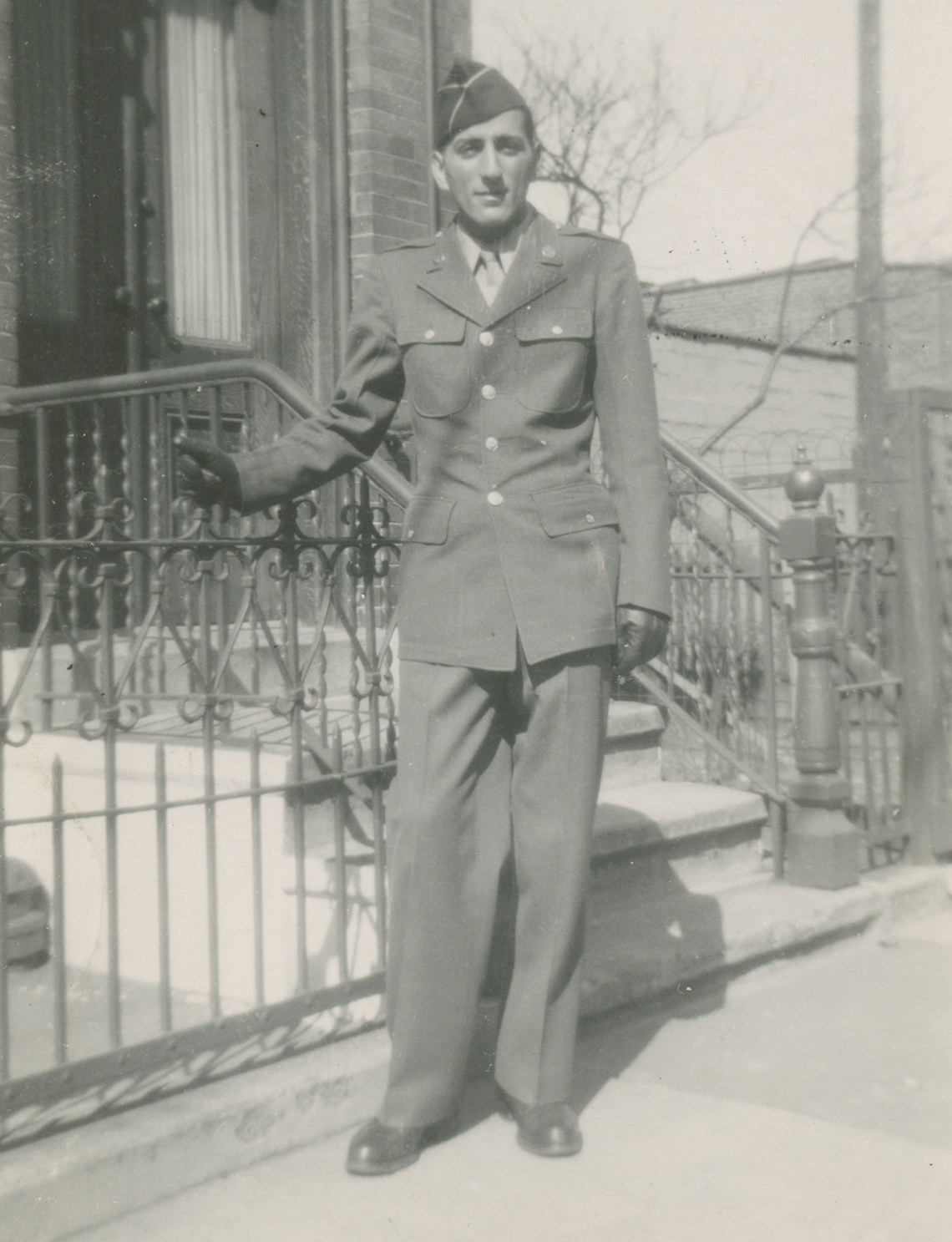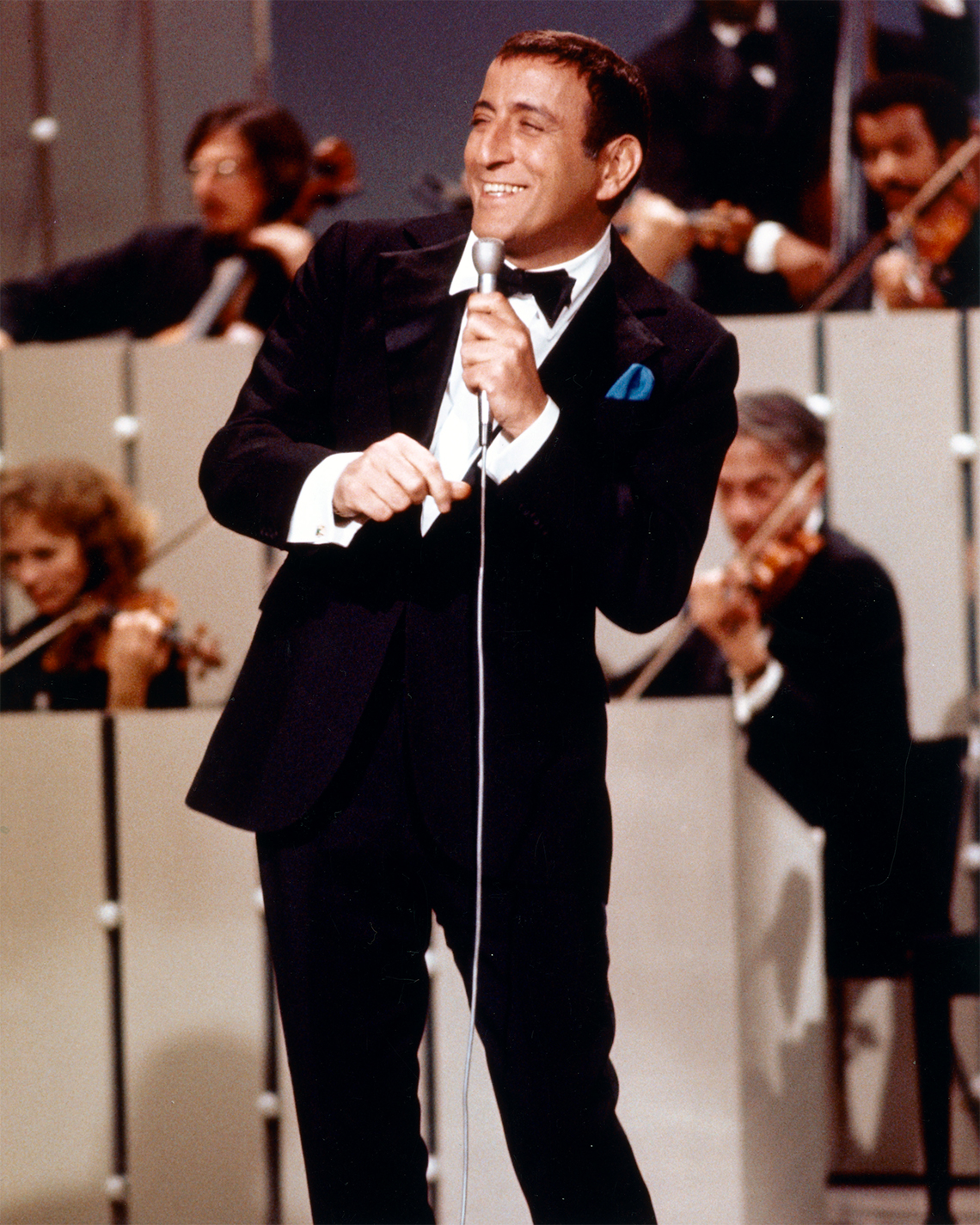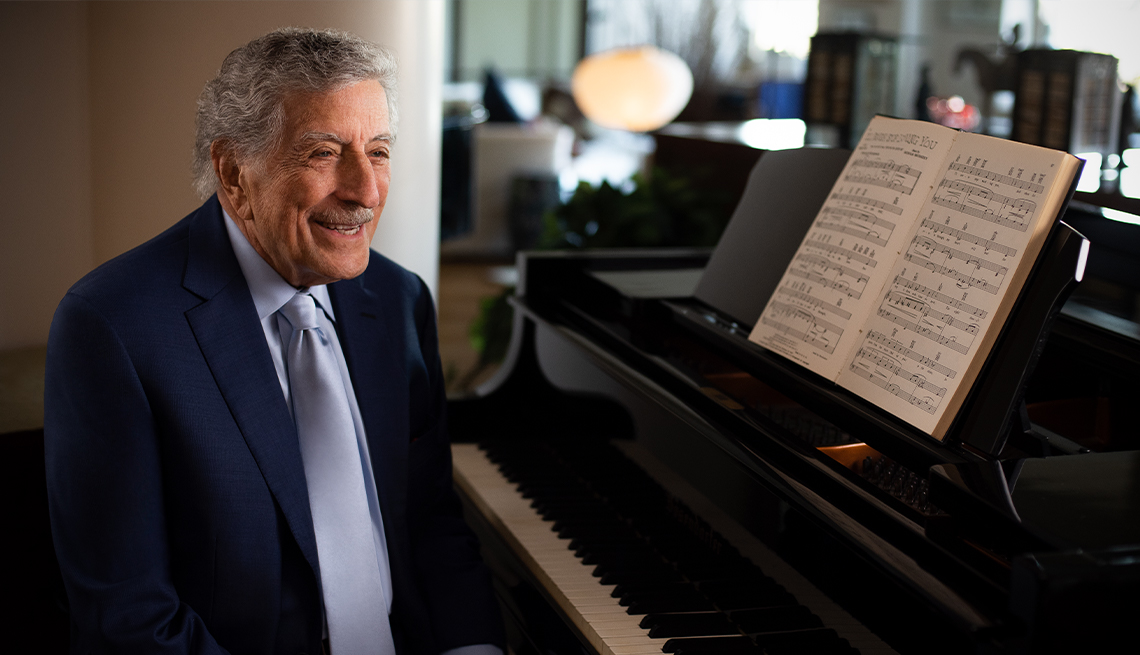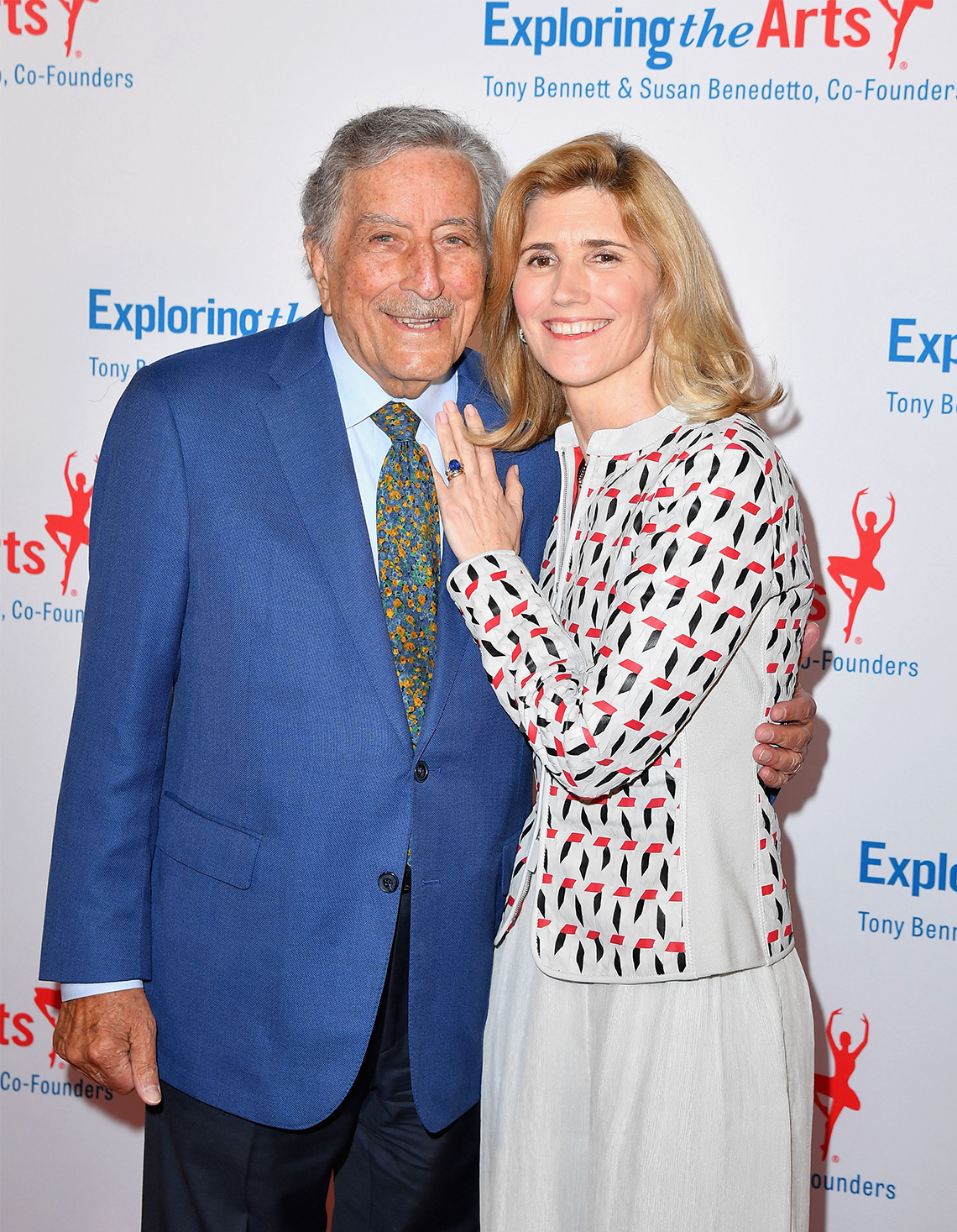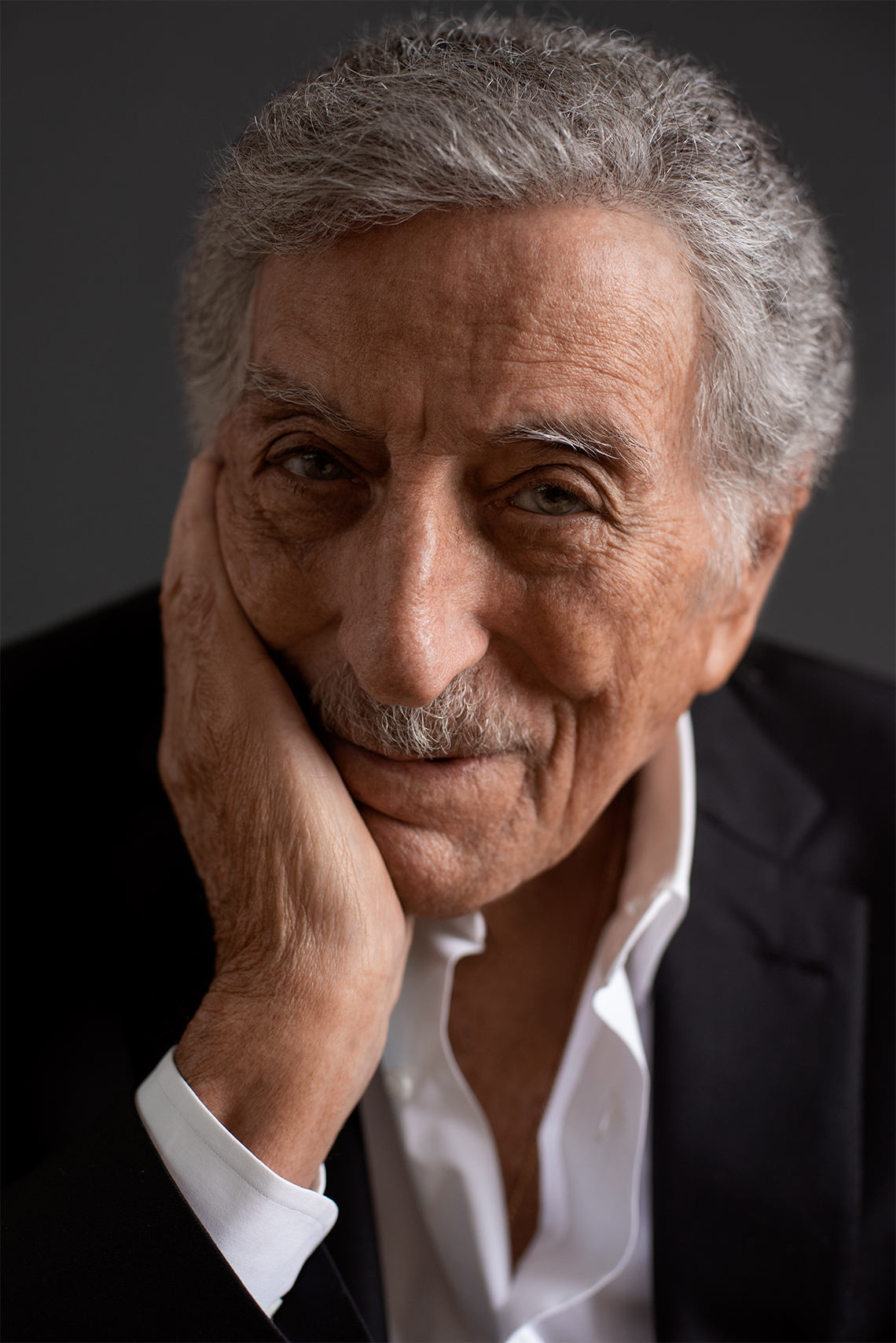Editor’s note: The legendary Tony Bennett died Friday, July 21, at age 96. AARP had the honor of spending time with Bennett in New York City as he was battling Alzheimer’s Disease. That special interview is chronicled below.
Part One: “It's Just Another Gift"
On an afternoon in early November 2020, I arrived at Tony Bennett's home on the 15th floor of a high-rise on the southern edge of New York City's Central Park. The sprawling three-bedroom apartment's wall of windows opens on a heart-stopping view of the park and floods the rooms with a steady north light — “a painter's dream,” as Bennett once said — which matters, because as well as being one of the world's greatest singers, he is also a serious visual artist. Over the last quarter century, he has spent untold hours in this sanctuary, a converted bedroom turned art studio where I was brought to meet him by his wife, Susan. This was clearly the space of a working artist: the walls papered with sketches, a messy table heaped with brushes and curled paint tubes, an easel by the window holding a work in progress — a black-and-white drawing of the park, the distant buildings expertly evoked with impressionistic flicks of charcoal.
Bennett himself was seated at a desk along one wall, his chair turned toward the windows as he paged slowly through a coffee-table book open on his lap. Nattily dressed in a blue blazer over an open-collared shirt, dark slacks and white running shoes, he was, at 94, startlingly youthful in appearance and instantly recognizable: the blue, heavy-lidded eyes, the iconic Roman nose, the coiffed salt-and-pepper hair. Missing, however, was the easy, ever-present smile that helped brand him the nice-guy singing idol of his generation — more approachable than the volatile Sinatra, or the jokily “drunken” Dean Martin. Instead, his expression had a masklike impassivity that changed only slightly to dim awareness when Susan, a slim, fine-featured 54-year-old, placed a hand on his shoulder, leaned over and said: “This is John, Tone. He's come to talk to us about the new album.” She spoke into his ear, a little loudly perhaps, in a prompting, emphatic register, as if trying to reach her husband through a barrier that had fallen between him and the rest of the world.
Indeed she was. He looked expressionlessly into my eyes before returning wordlessly to his book.
Tony Bennett has Alzheimer's disease, the most common form of age-related dementia. Alzheimer's is characterized by a progressive memory loss that robs its sufferers of many of the gifts that we all take for granted — speech, understanding, treasured memories, recognition of loved ones — and leaves them utterly dependent on caregivers. Bennett, first diagnosed in 2016, has so far been spared the disorientation that can prompt patients to wander from home, as well as the episodes of terror, rage or depression that can accompany Alzheimer's frightening detachment from reality; and, indeed, he might never develop these symptoms. But there was little doubt that the disease had progressed. Even his increasingly rare moments of clarity and awareness reveal the depths of his debility. At one point, as Susan and I stood chatting, he looked up suddenly from the book in his lap and, flashing that familiar smile, asked me in his soft, sueded whisper, “How's the weather outside?” Had I not known that he and Susan had just returned from walking their dog in the park, I might not have suspected that anything was amiss.
Such short-term memory loss is a hallmark of Alzheimer's stealthy onset, but long-term memories also progressively vanish — which lent an extra poignancy to the fact that the picture book that so gripped his attention was Tony Bennett Onstage and in the Studio (2018), a lavishly illustrated volume that featured photos from every stage of his life, from babyhood onward. He stared into its pages not with the air of warm reminiscence but like a man struggling to recall why these images seemed familiar. Although he can still recognize family members, he is, according to Susan, not always sure where he is or what is happening around him. Mundane objects as familiar as a fork or a set of house keys can be utterly mysterious to him.
Ten minutes into my visit, Tony's eldest son, Danny, joined us in the studio. “Hey, Pop,” he said. Tony glanced up, with a slight smile and nod, before returning silently to his picture book. Danny, an affable 66-year-old in black jeans and a Nehru-style jacket, has acted as his father's manager for the last 40 years. He was crucial to the mid-1990s career rebirth that made Tony (then in his late 60s) an unlikely staple of MTV — and which culminated in a 1994 best album Grammy for Tony Bennett: MTV Unplugged. Since then, Danny has masterminded a steady stream of memorable duet recordings featuring Tony and John Mayer, K.D. Lang, James Taylor, Sting, the late Amy Winehouse and Lady Gaga, who has become a devoted protégé. Their first, electrifying duet ("The Lady Is a Tramp” in 2011) proved to be a life-changing moment for Gaga when the 20-something glam-rock/techno-pop star realized, under Tony's tutelage, that she was (like him) also a jazz singer — someone who can riff off a melody, easily improvising harmonic detours of stunning beauty. “The fact that Tony sees me as a natural-born jazz singer is still something that I haven't gotten over,” Gaga recently said.
In 2014 Lady Gaga and Tony recorded Cheek to Cheek, an album of standards that debuted at number one on Billboard's Top 200 pop and rock chart — the kind of intergenerational success that simply cannot be ignored. Soon, a follow-up was being discussed. The songs were recorded, in widely spaced sessions, between 2018 and early 2020. After a number of delays, owing to Gaga's burgeoning movie-stardom (in A Star Is Born) and solo-recording career (including the release of her recent LPs Joanne and Chromatica) — to say nothing of the COVID-19 pandemic — the collaboration is finally being prepared for release this spring.
For more information about Bennett and Lady Gaga: www.TonyGaga.com
Tony was already showing clear signs of the disease, Susan said, when he and Gaga started recording the new LP at New York's Electric Lady Studios two years after his diagnosis. Indeed, Susan was not entirely sure that Tony was up to the task. “We'll try,” she recalled telling Danny. “That's all I can tell you. We'll try."
Before his illness, Tony was known as a meticulous and hard-driving perfectionist in the studio. The 2012 documentary The Zen of Bennett (shot three years before the onset of any symptoms) includes an electrifying moment when Tony, working to calm a nervous Amy Winehouse during their duet on “Body and Soul,” snaps at producer Phil Ramone, who has dared to intervene on the studio mic: “No — stay out of it! Let she and I work it out.” In another sequence, he snaps at his music arranger-piano player, Lee Musiker, for using too fast a tempo on “The Way You Look Tonight,” which they are rehearsing for a duet with Faith Hill. “It can't be a throwaway,” Tony says. “I wanna do a definitive version of this song!"
But Tony was a considerably more muted presence during the recording of the new album with Gaga. In raw documentary footage of the sessions, he speaks rarely, and when he does his words are halting; at times, he seems lost and bewildered. Gaga, clearly aware of his condition, keeps her utterances short and simple (as is recommended by experts in the disease when talking to Alzheimer's patients). “You sound so good, Tony,” she tells him at one point. “Thanks,” is his one-word response. She says that she thinks “all the time” about their 2015 tour. Tony looks at her wordlessly. “Wasn't that fun every night?” she prompts him. “Yeah,” he says, uncertainly. The pain and sadness in Gaga's face is clear at such moments — but never more so than in an extraordinarily moving sequence in which Tony (a man she calls “an incredible mentor, and friend, and father figure") sings a solo passage of a love song. Gaga looks on, from behind her mic, her smile breaking into a quiver, her eyes brimming, before she puts her hands over her face and sobs.
The new LP offers lush, gorgeous duets, with both singers in superb voice. But there is one duty, in connection with the record, that Tony is manifestly not able to perform: promotional interviews. (When I asked him, “Are you excited about the new record with Gaga?” he stared at me silently.) This has left those in charge of Tony's life and career — chiefly Danny and Susan — in a quandary. Eager for as many ears as possible to hear and enjoy what may very well be the last Tony Bennett record, they have jointly decided to break the silence around his condition, a decision they have, necessarily, had to make without Tony's input, since he is, Susan said, incapable of understanding the disease, let alone making momentous decisions about whether to publicly disclose it.
It is not easy for any family to break the silence around a loved one's diagnosis with Alzheimer's disease. Like cancer and mental illness, Alzheimer's carries a stigma, since people feel a special terror of an incurable disease that ruthlessly detaches its sufferers from the places, events and people that anchored them in life. Many treat it as an immediate death sentence and retreat from the world, encouraged to do so by family members who fear the disease and its unpredictable, and sometimes socially embarrassing, course. Researchers have recently raised alarms about the ill effects of such stigmatization. Gill Livingston, M.D., a University College London psychiatrist specializing in dementias, said that the silence around Alzheimer's only causes misconceptions and stereotypes to accrue around the disease, creating a vicious cycle that leads to further stigmatization and fear. “Panicking and hiding away is really unhelpful,” she said. “What we want is for people to be as open as they can, open within themselves and within their families, so that they can be supported in the things they can't do, and be helped to live a relatively full life. Support makes a great deal of difference.” Yet a recent push to raise awareness of the disease may have backfired to some degree, since people tend to hear only the frightening message that the illness is incurable and progressive — not that sufferers who receive loving support and timely medical attention can maintain a good quality of life and well-being for years.
“He is doing so many things, at 94, that many people without dementia cannot do. He really is the symbol of hope for someone with a cognitive disorder."
It is increasingly important for the more hopeful message to be heard. Over 5 million Americans have Alzheimer's disease. That number, doctors say, will likely rise to epidemic proportions as younger boomers (those born between 1954 and 1964) enter their late 60s and 70s. All of which means that staying silent about Alzheimer's will soon be as impossible for society as it has now become for Tony Bennett's family. And his story of Alzheimer's is, like the rest of his long life, inspirational. That he has maintained such good quality of life is testament to the support he receives from his family, his medical team and his friends — and lends credence to what Lady Gaga told Danny when he first informed her that they were thinking of breaking the silence around Tony's disease. “I wanted to check with her to make sure she was cool,” said Danny, “because she watches his back all the time. She was like, ‘Absolutely, it's just another gift that he can give to the world.’ “
Help for Your Loved One
One of the cruelest aspects of dementia is the stigma that surrounds it, says Sarah Lock, AARP's senior vice president for policy and brain health. Feelings of shame or hopelessness can cause people to resist getting diagnosed, or to refuse treatment. Although there is currently no cure for Alzheimer's disease, “there's a lot that people can do to delay symptoms and improve their quality of life,” Lock explains. “If people only knew about them, we could significantly save treatment costs, and we could save lives."
According to the Global Council on Brain Health, these six key behaviors can delay the onset of Alzheimer's and ease the course of the disease:
- Maintaining social ties
- Challenging the brain
- Managing stress
- Exercising regularly
- Eating right
- Getting restorative sleep For more information on building and preserving memory and cognition, visit aarp.org/brainhealth.
A healthy lifestyle alone doesn't resolve the challenges that dementia poses for patients and their families. AARP offers an online resource center (aarp.org/caregiving) for those caring for vulnerable loved ones. In partnership with the Alzheimer's Association, AARP created the Community Resource Finder (communityresourcefinder.org), with links to programs, events, medical services and other kinds of assistance for dementia patients and their caregivers.
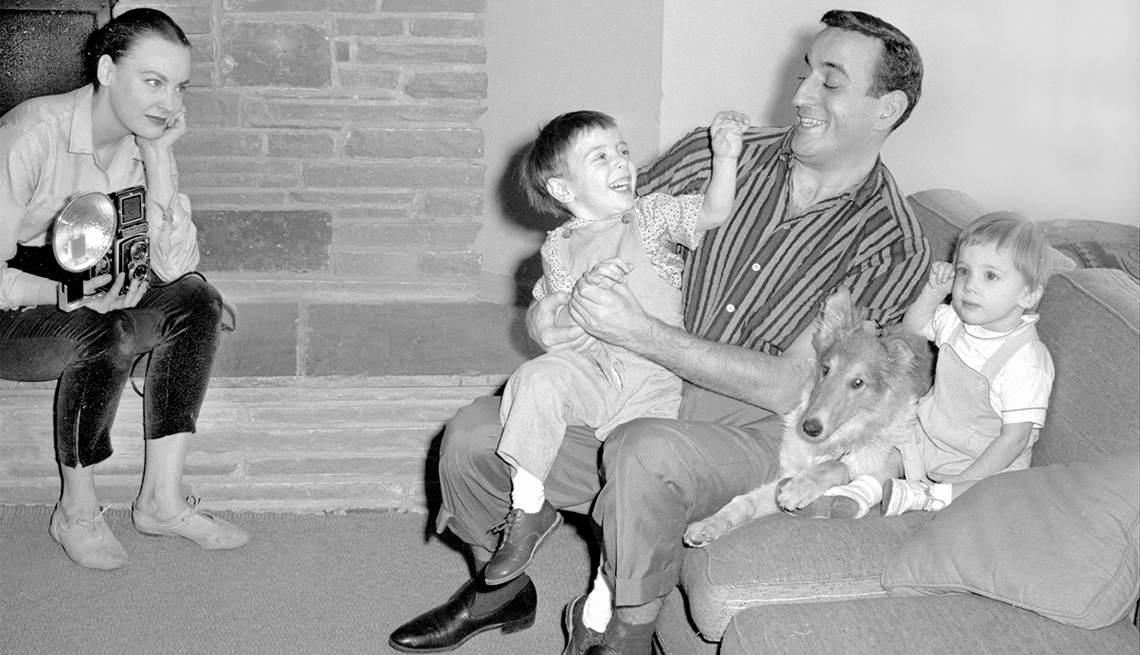
New York Daily News Archive via Getty Images
Tony with his sons, Danny and Daegal, and their dog, Pat, in 1957.
Part Two: His True North Was Always Family
Born Anthony Dominick Benedetto in Queens, New York, in 1926, he is the grandson of immigrants from the impoverished Italian province of Calabria. His father, a grocer, died of heart disease when Bennett was only 10, leaving Bennett's widowed mother to support the family of four on a seamstress's salary. Though he'd earned a place in a high school for aspiring artists on Manhattan's Upper East Side, Bennett quit at 16 to help support the family, working as a copyboy, and later as a singing waiter and band vocalist. Then in 1944, he turned 18 and was drafted into the Army and shipped to Europe for the terrible final months of World War II.
On the front line in Germany, he dodged bombs and shrapnel, dug foxholes in frozen ground, watched friends — fellow teenagers — die. Shortly before V-E Day, he helped liberate a concentration camp in Landsberg, near Dachau. This experience, coupled with the racial prejudice to which he had been subjected by fellow American soldiers (for his Italian heritage, and for befriending Black soldiers), cemented his ideas about the evils of prejudice. Years later, he was one of the few white entertainers to join Martin Luther King Jr.'s march for equal rights in Selma, Alabama.
He sailed home to New York in August 1946, the month he turned 20. As part of the occupying force in Germany, he'd entertained his fellow soldiers, singing with an expert big band, honing his chops. But back home, headlining jobs eluded him. Under the stage name “Joe Bari,” he took unpaid gigs at small clubs, fell in love with the new sound of bebop and began using his voice to mimic Charlie Parker's sax and Art Tatum's piano. He also took advantage of the GI Bill to study bel canto, the breathing and articulation techniques used by opera singers to achieve, without strain, roof-lifting vocal crescendos.
Eventually, he landed an engagement at the upscale Shangri-La in Astoria, which led to guest spots on the radio. But his life-changing break came when Pearl Bailey, the popular singer and actress, tapped him to sing with her at a Greenwich Village club, the Village Inn. Bob Hope dropped in to catch a set and invited him to sing at his upcoming New York shows. Hope had one demand: The just-folks name Joe Bari was all wrong for a singer of Tony's elegance and style. On the spot, Hope edited a few syllables from the singer's birth name — and renamed him Tony Bennett.
Studies have shown that, as a preventative against Alzheimer's disease and as a way to mitigate its effects, a Mediterranean diet — high in olive oil, fresh fruits and vegetables, legumes and fish — is beneficial. Susan, as Tony's main caregiver, has kept him on the diet. She also oversees his three-day-a-week exercise regimen, aware that improved blood flow is thought to slow the progress of memory loss. A few minutes before 4 p.m. on the day I visited, Tony's trainer, an outgoing young man named David, put the singer through a set of exercises that would have challenged someone three decades younger. They started with upper-body exercises, Tony pulling on thick elastic bands, then moved to aerobic work: Tony jogged up and down the hallways. Then on to lower-body work: stepping on and off a 6-inch-high box, plus six sets of squats. Though he did not speak, Tony responded to David's instructions and, at one point, as he sat puffing for breath in his chair, he reached suddenly for Susan's hand. She clasped it. “Feels good to work out, huh, cutie?” she said.
"Yeah,” Tony said.
"Good!” Susan replied.
Susan's devotion to Tony is impressive to witness — and it goes back to before she even met him. Born in San Francisco in 1966, she was an unlikely fan of his music. When every other kid was listening to Elton John or the Stones, Susan was phoning local radio stations to request Tony's songs, begging her parents to take her to his concerts, and eventually heading up the local chapter of his fan club. She came by her fascination honestly, given that her mother, Marion, was also a longtime fan — indeed, one of the original “Tonymaniacs,” the army of teenage bobby-soxers who, at the dawn of the 1950s, fueled Tony's first taste of fame. Marion was 14 in 1950 when Tony, fresh off the triumph of performing with Bob Hope, signed a recording deal with Columbia Records. A year later, he scored his first smash, “Because of You,” a velvety ballad that spent 10 weeks at number one and attracted so many screaming fans to his concerts that police barricaded the venues.
For the next 10 years, Bennett scored hit after hit, among them “Cold, Cold Heart” and “Rags to Riches.” In 1955, he put out a sophisticated jazz album, Cloud 7, backed by a combo of drums, bass, piano, muted electric guitar, sax and trumpet. That same year, in a move that would prove typical for a man whose true north was always family, Bennett hired his sister, Mary, as his manager. Until the demands of motherhood forced her to step away a decade later, Mary helped shepherd her brother's career, including the release, in 1962, of his signature tune and one of his top-selling singles ever: “I Left My Heart in San Francisco."
With this, Bennett had reached the stratosphere of international stardom. But then came the British Invasion. Overnight, Tony's singing style, song choice, haircut, clothing — indeed his entire generation (in 1964, he was 38) — was rendered obsolete. Worse: uncool. Even worse: square. In short order, record sales cratered, concerts dried up. Meanwhile, his first marriage, to a Cleveland beauty named Patricia Beech, was in ruins. They had married at the height of Tonymania, had two children in quick succession (Danny in 1954 and his brother Daegal — a Scandinavian name that Patricia liked — the following year), but his constant touring had driven a wedge between them, and then his career slide widened it. They separated in 1965, and later divorced.
The bad juju kept coming. Columbia Records demanded that every act do rock music. Tony refused — but in 1970, career on life support, he capitulated and released Tony Sings the Great Hits of Today. The first time he heard the record, he has said, he literally threw up. He refused to record a follow-up, and in 1971 quit Columbia. Within a few years, he had started his own label, Improv, and in 1975 and 1977, he put out two highly respected jazz albums with the tortured piano genius Bill Evans. Unfortunately, the records didn't sell.
Bennett had, by now, married aspiring actress Sandra Grant. Their daughters, Joanna and Antonia, were born in 1969 and 1974 and the family relocated to Los Angeles, where Tony embraced the celebrity lifestyle of endless parties and cocaine that “flowed as freely as champagne” (as he put it in his 2007 autobiography, The Good Life). In 1977, Improv folded, leaving Tony saddled with its debt. His beloved mother died ("I was so overcome with grief I actually wondered if I might be losing my mind") and the IRS, to which Tony was in arrears, began proceedings to seize his Beverly Hills house. In the midst of this maelstrom, Tony, groggy on booze and drugs, fell unconscious in a running bath. Sandra pulled him out and resuscitated him, but the marriage was over: The couple divorced. Bennett had found rock bottom. But he also knew the only way out: family.
In 1979, his sons, Danny and Dae, then 25 and 24, respectively, had worked for a decade as touring rock musicians, Danny said, “and of course we'd grown up in the business. I always had an eye for contracts and legal stuff and Dae, who had moved into production, had great instincts.” Tony summoned both sons out to Los Angeles, where he broke down and confessed: “I'm lost.” He had no idea how to dig himself out financially, or how to resume his dead career. Danny, signing on as Tony's manager, drew up a three-year payment plan with the IRS and cut Tony's spending, moving him back to New York City. Then they focused on the music.
Convinced that people his own age and younger need only hear his father's music to fall in love with it, Danny first established name and face recognition for Tony by cajoling SCTV, a Canadian comedy show popular with college kids, into putting Tony in an episode. He got a Tony Bennett storyline into The Simpsons and booked him on Letterman. He also cut back on Tony's Vegas shows — too shlocky — and arranged for hipper gigs at New York City's Bottom Line and Village Vanguard and a show at Carnegie Hall.
Columbia Records wanted Tony back, and Danny used this leverage and oversaw a highly advantageous recording contract for his father. In 1986, Tony released his first Columbia record in 14 years: The Art of Excellence. In an era when Huey Lewis was assuring kids that it's “hip to be square,” Tony Bennett, coiffed and besuited, was once again cool. MTV gave him a slot on its music awards show with members of the Red Hot Chili Peppers. But when MTV programmers started talking excitedly about Tony singing the young guys’ rock tunes, Danny let them know his client's ironclad demand: Duets are fine, but the kids sing Tony's music! MTV got the message. When Elvis Costello and K.D. Lang joined Tony for the April 1994 taping of his MTV Unplugged session, they sang with him on Great American Songbook tunes. The resulting album, Tony Bennett: MTV Unplugged, became one of the best-selling of his career. “Tony Bennett has not just bridged the generation gap,” The New York Times wrote, “he has demolished it.” Tony used the Unplugged windfall for “one luxury,” he later wrote: a “lovely apartment on Central Park South" — the apartment where I visited him last fall. With him, when he moved in, was Susan.
“Singing is everything to him. Everything. It has saved his life many times."
The two had fallen in love in 1985, when Susan, then 19, used her fan-club credentials to get backstage at a show. At 58, Tony was nearly 40 years her senior, but Susan, by all accounts, was already a person of uncommon self-possession and sobriety. That's abundantly clear when she alludes to Tony's late-'70s collapse into drugs. “That was before me,” she said, “because I never would have tolerated it."
They settled into a life together in New York where he pursued his two passions, painting and singing, and she finished her education and became a social studies teacher. Together, they cofounded Exploring the Arts, a charity that raises money for public schools, and in 2001 they created the Frank Sinatra School of the Arts, in Tony's home borough of Queens. In 2007, Tony and Susan married in New York's City Hall. Still playing over a hundred dates a year, Tony, then nearly 81, asked his new bride to join him on the road. “I was, like, fine. Twist my arm!” Susan recalled. “It's a great life.” That blessed existence continued until a day in 2015 when Tony complained to Susan that he couldn't remember the musicians’ names onstage. “So, we got him a list that he put on the piano,” Susan said, “but he wasn't happy about it.” She wasn't worried, though. She thought it was normal aging. After all, he had recently turned 90. But Tony evidently knew something was wrong. He wanted to see a doctor.
Questions to Ask When Dementia is Diagnosed
Information can guide patients and families through next steps
A diagnosis of dementia, whether your own or a loved one’s, can leave everyone involved feeling overwhelmed, anxious and uncertain about what the future will hold. It’s important to gather as much information from your doctor as you can, starting with these key questions, compiled by the University of California at Los Angeles Alzheimer’s and Dementia Care Program, which helps dementia patients and their families navigate the complex medical, social and emotional issues associated with their diagnosis.
- What type of dementia do I have?
- What’s the difference between Alzheimer’s disease and dementia?
- What caused my dementia?
- What symptoms, other than memory loss, can I expect, and what will the pace of decline be?
- What can I do to slow the decline? (What medicines are effective and what results can I expect from them? What lifestyle changes will be helpful?)
- What plans should I make now to prepare for a time when I can be less engaged in making decisions?
- How should I select a family or friend caregiver?
- Should I tell people about my diagnosis?
- What are the chances that my children will get dementia, and is there anything they can do to prevent it?
- What help is available to guide me through my illness, and where can I get more information about it?
Additional questions to ask your doctor after a dementia diagnosis can be found here.
Part Three: Complete Honesty and Love
Gayatri Devi, M.D., a neurologist at Lenox Hill Hospital in Manhattan, diagnosed Tony in 2016. She has studied the disease for 25 years and is the author of the book The Spectrum of Hope, which describes Alzheimer's disease as a “spectrum disorder,” one that varies greatly from person to person. Quality of life, progress of the disease and how long a sufferer lives depend first, Devi said, on what kind of brain they bring to the situation. “And Tony Bennett,” she told me, “brought an amazingly versatile brain.” He has some “cognitive issues, but multiple other areas of his brain are still resilient and functioning well,” she said. “He is doing so many things, at 94, that many people without dementia cannot do. He really is the symbol of hope for someone with a cognitive disorder."
As well as taking the standard Alzheimer's medications (cholinesterase inhibitors that regulate the concentration of the brain's chemical messengers for normal memory function) and his regimen of diet and exercise, Devi said that Tony's continued high functioning and well-being is attributable to his strong family support — and especially that of his prime caregiver, Susan. “I've been humbled by the level of devotion,” Devi told me. “She also expects a lot from him. I think her background as a teacher helps, but she's also very much in love with him. And he rises to her expectations.” She cited moments when Tony, in her clinic's waiting room, is recognized by a fan. “Susan will say, ‘Tony B! A fan of yours is saying hello!’ And he then turns to the person with his big blues, smiles his smile and says, ‘How are you?’ or ‘Thank you!’ The charisma and magnetism get turned on.” Such moments of connection and awareness are beneficial, Devi said, because they stimulate the brain.
Since the COVID lockdown last March, Susan has had to let their assistant go to minimize Tony's potential exposure to the virus. That only increased his total, minute-to-minute dependence on her. The stresses of caring for an Alzheimer's patient can be acute. Because Tony does not wander, Susan can leave him with someone else for an hour to run errands, but otherwise is with him in the apartment. “I have my moments and it gets very difficult,” she said. “It's no fun arguing with someone who doesn't understand you,” she said with a rueful laugh. “But I feel badly talking about it because we are so much more fortunate than so many people with this diagnosis. We have such a good team. Danny handles Tony's business affairs. We have great doctors, David helping us with the exercise.” And Tony himself remains content and happy. It has been that way ever since the diagnosis, which he took calmly. “But that's because he already didn't understand,” Susan said. “He would ask me, ‘What is Alzheimer's?’ I would explain, but he wouldn't get it. He'd tell me, ‘Susan, I feel fine.’ That's all he could process — that physically he felt great. So, nothing changed in his life. Anything that did change, he wasn't aware of."
One thing that did not change was Tony's love of music and singing. Music's peculiar power to reach even severely afflicted dementia patients, stirring memories and reestablishing connections to those around them, is well documented but not well understood. The documentary Alive Inside (2014) shows nursing home patients with severe dementia aroused from immobility and silence when issued earbuds and iPods with the favorite music of their youth. One patient, a silent 94-year-old man, begins speaking volubly about his childhood and is able to recall his forgotten daughter after a session of listening to his beloved Cab Calloway. Neuroscientist and musician Daniel Levitin, author of the best sellers This Is Your Brain on Music and Successful Aging, points out that it is music's primarily emotional appeal that enables it to tap memories not otherwise accessible to a mind afflicted by Alzheimer's disease. Even severely affected patients are often able to recall the lyrics and melodies to songs they loved in adolescence, a time of high emotionality and self-discovery when the developing brain “tags” memories as particularly salient and important. This would go far to explain the astonishing fact that after his diagnosis with Alzheimer's, Tony Bennett continued to tour extensively, singing his 90-minute set of sophisticated music with such panache, precision and professionalism that audiences and critics never suspected his condition.
Devi, his neurologist, strongly encouraged Danny and Susan to keep Tony singing and performing for as long as he could happily do so. “It kept him on his toes and also stimulated his brain in a significant way,” Devi told me. Both Susan and Danny said that backstage, Tony could seem utterly mystified about his whereabouts. But the moment he heard the announcer's voice boom “Ladies and gentlemen — Tony Bennett!” he would transform himself into performance mode, stride out into the spotlight, smiling and acknowledging the audience's applause. And start singing. Still, Susan spent every performance, post diagnosis, worried about him losing a lyric, panicking, growing confused onstage. “I was a nervous frigging wreck,” she said. “Yet he always delivered!"
And he did so right up to his last public performance, on March 11, 2020, at the Count Basie Center for the Arts in Red Bank, New Jersey — after which the COVID-19 pandemic forced all musical acts off the road. Just how therapeutically beneficial performing had been for Tony soon became obvious when his world shrank to the confines of his apartment. “This has been a real blow from a cognitive perspective,” Devi told me. “His memory, prior to the pandemic, was so much better. And he's not alone. So many of my patients are negatively affected by the isolation, the inability to do the things that matter to them. For someone like Tony Bennett, the big high he gets from performing was very important."
So, Devi recommended that Tony continue to rehearse, and twice a week, his longtime pianist Lee Musiker, who lives a mere three-minute walk away, comes to the apartment and runs through Tony's 90-minute set with him. On the day that I was visiting, Musiker arrived and stuck his head into the art studio where I was sitting with Susan, Danny and Tony. “Hi,” he said. “I'll go set up.” Susan led Tony from the studio to the adjoining living room, an oceanic space that held a black Bösendorfer grand piano. At the far end of the room, under a huge picture window holding a vista of the park, was an arrangement of sofas and chairs beneath a large canvas by Tony's friend, the renowned English artist David Hockney. This was a rehearsal, not a performance, so Tony faced his accompanist, his back to the nearby dining table where Susan, Danny and I sat.
Musiker placed a set list on the piano in front of Tony, but they didn't stick to it. Indeed, the first chord Musiker hit was from a song that wasn't on the list and that Tony hadn't sung much in recent years. Yet immediately, incredibly, he opened his mouth and out rolled a stream of rich, resonant notes, swelling up and outward from the lower part of his range, the melancholy tone perfectly matched to the lyric, which he produced with his famously clear articulation: “Maybe this tiiiime, I'll be luckyyyy …” The song was “Maybe This Time” by John Kander and Fred Ebb, made famous by Liza Minelli in the movie Cabaret in 1972, which is when Tony recorded it, in a stunning performance that he reproduced now. The song built in intensity as the lyrics and aching melody mounted into his high register, a full three octaves from where he started, increasing in volume and power until he was filling the room with a crescendoing cry: “It's got to happen, happen sometime—maybe this time, I'll winnnnnnn!"
Our Tony Top 10
1950: Boulevard of Broken Dreams
Tony's first single with Columbia
1951: Because of You
First No. 1 hit
1953: Rags to Riches
Later opened the film Goodfellas
1959: Smile
A definitive take on the Charlie Chaplin classic
1962: I Left My Heart in San Francisco
Homesick ballad by a pair of unknowns
1965: The Shadow of Your Smile
Wrings a tear with oboe-like low notes
1965: Fly Me to the Moon
A spine-chilling, melancholy treatment
1975: But Beautiful
Reflects his midlife pain and doubt
2011: Body and Soul (with Amy Winehouse)
A heartbreaking jazz improvisation
2011: The Lady Is a Tramp (with Lady Gaga)
These two have such fun it's palpable. —J.C.
Neuroscience even today cannot explain how a man whose speaking voice has become so hesitant — whose memory of events, people and places has largely vanished — can, at the sound of a musical cue, lift his voice in song with such beauty and expression, except to say that music and singing emerge, as Levitin has pointed out, from areas of the brain quite distinct from those associated with speech and language. The powerful feelings released by music can connect listeners to their deep emotional memories, even those inaccessible to the conscious mind.
And so it went, for the next hour, a miraculous concert that was, quite literally, a gift for an observer and a stroll down memory lane.
"How about the Duke Ellington tune?” Musiker said — and right away, Tony's voice floated toward the ceiling like notes from a lovely muted trumpet.
"In my solitude,” he sang, “You haunt me/ With dreadful ease/ Of days gone by./ In my solitude/ You taunt me/ With memories/ That never die."
On “Boulevard of Broken Dreams,” the first single he cut for Columbia, in 1950, Tony, at 23 years old, had ended the song with a full bel canto window-rattler — and astonishingly he reproduced it now: “… and dance along the boulevaaaaaahd of brooooooken dreams!” On “Fly Me to the Moon,” he lofted his voice gently into the air just as he had done in his gorgeous 1965 recording, and on the up-tempo “The Lady's in Love With You,” he nimbly moved through the intricate lyrics as if scatting. He ended his rendition of “Smile” ("… though your heart is breaking …") with a long-drawn “smiiiiiiiiiiile” that made Susan use an expression that Tony liked to say when he nailed the definitive version of a song: “Right in there,” she said. Musiker shook his head in amazement, looked at Tony and thumped his fist against his heart.
"This is it,” he said to Tony. “The heart."
"Every time,” Tony said — his first spontaneous verbal reaction of the afternoon. As the rehearsal went on, he increasingly traded short conversational back-and-forths with Musiker. At the end of a rousing “When You're Smiling,” Musiker jokily alluded to their audience of three people as 3 million people. “Actually,” he added, “you once said that if even one person — remember you said this years ago?"
"Oh, yeah,” Tony said.
"If there's one person in the club,” Musiker said.
"Then you really give it to him,” Tony said. “It's really intimate that way.”
Later, when I spoke with Musiker about what makes Tony special, he said, “Proper vocal training and a musician's innate sense, not a singer's innate sense. Like an instrumentalist, he hears it all. Constantly knocks me out. Then the complete honesty and love.”
The often-miraculous way music can reconnect dementia patients to family and friends, memory and the past, is, alas, temporary. Lucidity, memory, conversation may linger for a few minutes. But for those who yearn for the old connection, who desperately miss the spark of animation in a loved one, even these brief glimpses of the person they knew, these fleeting connections, arrive like a blessing. For Susan, the obvious pleasure that Tony takes in singing is a precious gift. “I wish he kept up his painting, but that hasn't latched in like the singing has.” The charcoal landscape on his easel, she said, was a rarity. But not the singing. Not yet. “Singing is everything to him,” Susan told me, as I was packing up to leave. “Everything. It has saved his life many times. Many times. Through divorces and things. If he ever stops singing, that's when we'll know …” Her voice catching, she stopped.
Two days earlier, the actor Sean Connery had died, at age 90, of dementia. Connery's widow said that in his final months he had been unable to communicate, but that he, thankfully, had slipped away quietly in his sleep. “I'm hoping for that with Tony,” Susan told me. “Hopefully he'll just go to sleep one night and that will be that. I'm hoping and praying that he won't take a turn for the worse that's really crazy bad.” She fell silent for a moment. Then she smiled. “There's a lot about him that I miss,” she said. “Because he's not the old Tony anymore.” Again, her voice caught and she looked down. Then she mastered herself, looked up at me and smiled. “But when he sings, he's the old Tony."
What We Are Doing
AARP has made a long-term commitment to fighting dementia. Our ongoing efforts include the following:
Dementia Discovery Fund: AARP contributed $60 million to this venture capital fund for research and development of cutting-edge treatments.
Global Council on Brain Health: A council of researchers and policy experts meets regularly to discuss recent findings on brain health and translate them into simple actions the public can take to stay sharp. The council was created in 2015 by AARP and Age UK.
Alliance to Improve Dementia Care: AARP is a founding member of this coalition, convened by the Milken Institute Center for the Future of Aging. The alliance, announced last year, seeks to build consensus to improve the health care and long-term care systems for people living with dementia.
Alzheimer's Disease Data Initiative: As a member of this coalition of research and advocacy groups brought together by Bill Gates, AARP seeks to connect researchers to the data they need to develop new treatments and diagnostic tools for dementia.
UsAgainstAlzheimer's: Last summer, AARP joined this group of more than 80 health and advocacy organizations to press the federal government for action on dementia prevention. The goal is to create a national effort similar to efforts to reduce heart disease.
Staying Sharp: AARP's digital platform (aarp.org/stayingsharp) offers advice and exercises to help keep your brain healthy.
Women’s Alzheimer’s Movement (WAM): AARP is partnering with WAM, founded by Maria Shriver, on a five-step action plan to advance progress on women’s brain health based upon our recent report, It’s Time to Act: The Challenges of Alzheimer’s and Dementia for Women, supported by the AARP Foundation’s A. Barry Rand Fund for Brain Health Research.
Journalist John Colapinto is a longtime contributor to The New Yorker and Rolling Stone and author of the nonfiction best seller As Nature Made Him. His book on the human voice, This Is the Voice, was published in January.

